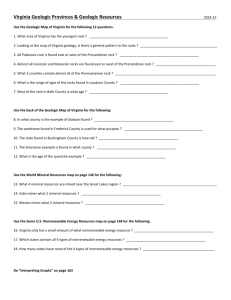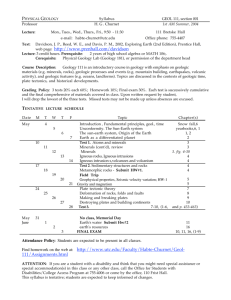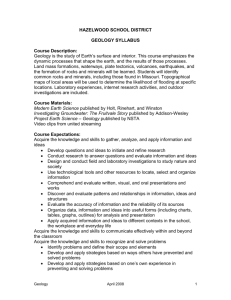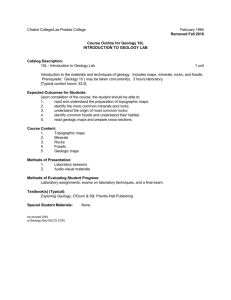Geology Test Explanation
advertisement
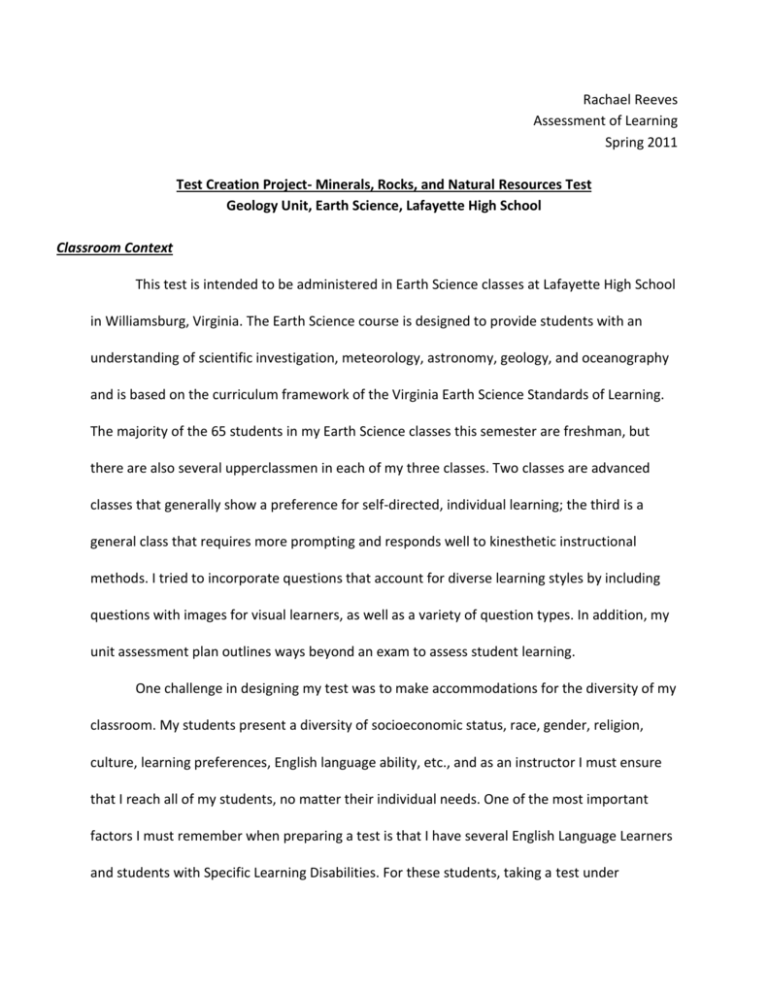
Rachael Reeves Assessment of Learning Spring 2011 Test Creation Project- Minerals, Rocks, and Natural Resources Test Geology Unit, Earth Science, Lafayette High School Classroom Context This test is intended to be administered in Earth Science classes at Lafayette High School in Williamsburg, Virginia. The Earth Science course is designed to provide students with an understanding of scientific investigation, meteorology, astronomy, geology, and oceanography and is based on the curriculum framework of the Virginia Earth Science Standards of Learning. The majority of the 65 students in my Earth Science classes this semester are freshman, but there are also several upperclassmen in each of my three classes. Two classes are advanced classes that generally show a preference for self-directed, individual learning; the third is a general class that requires more prompting and responds well to kinesthetic instructional methods. I tried to incorporate questions that account for diverse learning styles by including questions with images for visual learners, as well as a variety of question types. In addition, my unit assessment plan outlines ways beyond an exam to assess student learning. One challenge in designing my test was to make accommodations for the diversity of my classroom. My students present a diversity of socioeconomic status, race, gender, religion, culture, learning preferences, English language ability, etc., and as an instructor I must ensure that I reach all of my students, no matter their individual needs. One of the most important factors I must remember when preparing a test is that I have several English Language Learners and students with Specific Learning Disabilities. For these students, taking a test under “normal” circumstances may not allow them to express their knowledge accurately. For these students, accommodations must be made. To accommodate these students’ testing needs, I would allow extra time to take the test, perhaps in the Media Center or during our Academic Enrichment Period (which is like a built in study hall for all students). Additionally, I would shorten the test by removing several of the multiple choice questions that fall under the “Physical and chemical properties of major rock-forming and ore minerals” and “Mineral composition and texture of common rock types” categories. These categories are especially important to the unit, which is represented by their relative abundance on the test. However, I think removing several of these questions to make the test more accessible to ELL students and students with IEPs will not impair my evaluation of these students’ test results. Geology Unit Overview The geology unit is the largest and most intensive unit of the Earth Science curriculum. The Virginia Earth Science standards place a huge emphasis on geology: 21 of the 50 questions on the Earth Science SOL test and 5 of the 14 SOL objectives fall under the category of geology. The Williamsburg-James City County pacing guide reflects this accentuation and suggests that nearly twice as many blocks be spent teaching geology than any other topic. Five weeks will be devoted to geology, and within that five weeks I plan a range of assessments: two tests, a project, a lab practical, and class work/ homework. The specific content covered in the unit and the assessments covering that content can be seen in the unit table of specifications below. The test will fit into my cooperating teacher’s grading scheme, in which tests and quizzes account for 60% of a student’s final grade. Class work and homework compose the other 40%. Because my cooperating teacher does not assign projects, my plan to include a project in my unit assessment plan must be fit into his grading scheme as a test grade. Currently, my cooperating teacher only gives multiple choice tests. Although I understand the importance of preparing students for standardized test situations that rely on multiple choice questions to cover a breadth of information with relative ease, I also recognize the limitations of multiple choice. In my exam, I use matching items to cover a list of basic concepts and definitions that are integral to understanding the unit. Then, I use multiple choice to test students achievement of the knowledge and comprehension level ILO. However, multiple choice cannot assess the highest cognitive levels, so to test these ILO I use supplyresponse items such as short answer and essay. This exam will cover the rocks, minerals, and natural resources segment of the geology unit, which equates to approximately half of the Geology Standards of Learning. Although they are included in the geology unit, this test will not include plate tectonics, Earth history, or Virginia geology. In addition to this test, I will also assess student learning in this unit through a lab practical, formative class work assignments, and a creative project. My instructional approach is inquiry-based, which allows me to assess my students’ progress before, during, and after inquiry activities. I often ask students challenging questions as they explore a topic in a simulation, lab, activity, etc. Their written and verbal answers to my questions indicate how much explanation I need to do so that my students fully understand a concept. After I explain, I often give them a wrap-up or clarifying activity from which they can organize and refine their understanding, and I can observe how much they have learned. By watching my students work through these in-class activities, I gain insights that let me evaluate their understanding and make plans for future lessons. One of the major outcomes for this unit is that students will be able to identify major minerals and rocks based on their physical properties. Although I included test items that require students to understand how to identify rocks and minerals, these questions don’t actually test whether or not a student can identify a rock or mineral sample. To test this skill, a lab practical is necessary. Students should be able to identify some basic minerals (including coal, one of Virginia’s most important resources), tell a rock’s type, and answer general questions about a rock or mineral in a lab setting. Students will be given a rock or mineral sample and be asked questions about it. As indicated by the unit table of specifications, the assessment should remain at or below the comprehension cognitive level. An example question may be “Is igneous rock #4 intrusive or extrusive?” When evaluated in tandem with students test results, the lab practical will give a broad picture of students’ practical skills and factual knowledge of rocks, minerals, and natural resources. Assessment for the second half of the geology unit will be centered on class work, a Virginia geology project, and a test. Instruction during this part of the unit may be shaped by the results of the previous set of assessments. Insights gained from the part 1 test and lab practical will inform me how my students are learning and what topics they are having difficulty with. It may be necessary to revisit topics or alter my instruction to account for weaknesses in certain skills. In this part of the unit, students will be able to create and express their knowledge in a creative medium. For my Virginia geology project, I ask students to research one of Virginia’s geologic provinces or a prominent geologic feature in Virginia. In addition to the geologic significance and origin of their topic, they will also research the feature’s economic and social impacts. They are then to express this knowledge in a creative format, such as a poster, pamphlet, or photo-story. For example, a student may discover that the Appalachian Mountains are one of the oldest geologic features in the United States and also are vital to the tourist economy of Virginia, so they make a tourism brochure for the region. My intention for this project is that students will become an “expert” on an aspect of Virginia’s rich geologic history, share that knowledge with their classmates, and express their learning in a creative way. This creative project will be supplemented with a test covering the physiographic provinces of Virginia, plate tectonics, geologic processes, geologic history diagrams, and relative/absolute dating. Geology Unit Intended Learning Outcomes This unit is intended to assess students’ acquisition of the Virginia Earth Science Standards of Learning numbers 5, 6, 7, 8, and 9. These standards are listed below, along with the unpacked intended learning outcomes contained in each state-written standard. The bolded verbs indicate the cognitive level of each ILO, while the underlined phrases indicate the content of each ILO. The rocks, minerals, and natural resources test is only designed to test SOL 5, 6, and 7, the remaining SOL will be assessed in the other forms discussed in the unit assessment plan. ES.5- The student will investigate and understand how to identify major rock-forming and ore minerals based on physical and chemical properties. Key concepts include a) hardness, color and streak, luster, cleavage, fracture, and unique properties; and b) use of minerals. ILO: Students will be able to describe uses of common minerals. Students will be able to identify and name major rock-forming and ore minerals based on physical and chemical properties. ES.6- The student will investigate and understand the rock cycle as it relates to the origin and transformation of rock types and how to identify common rock types based on mineral composition and textures. Key concepts include a) igneous (intrusive and extrusive) rocks; b) sedimentary (clastic and chemical) rocks; and c) metamorphic (foliated and unfoliated) rocks. ILO: The student will be able to name, label, and explain the rock cycle. The student will be able to identify and name common rock types based on mineral composition and textures. The student will be able to classify a given rock type as igneous, metamorphic, or sedimentary ES.7- The student will investigate and understand the difference between renewable and nonrenewable resources. Key concepts include a) fossil fuels, minerals, rocks, water, and vegetation; b) advantages and disadvantages of various energy sources; c) resources found in Virginia; d) making informed judgments related to resource use and its effects on Earth systems; and e) environmental cost and benefits. ILO Students will understand the differences between renewable and nonrenewable resources Students will be able to analyze the advantages and disadvantages of various energy sources. Students will be able to name Virginia’s natural resources Students will be able to make informed judgments related to resource use based in part on environmental costs and benefits. ES.8- The student will investigate and understand geologic processes including plate tectonics. Key concepts include a) how geologic processes are evidenced in the physiographic provinces of Virginia including the Coastal Plain, Piedmont, Blue Ridge, Valley and Ridge, and Appalachian Plateau. b) processes (faulting, folding, volcanism, metamorphism, weathering, erosion, deposition, and sedimentation) and their resulting features; and c) tectonic processes (subduction, rifting and sea floor spreading, and continental collision). ILO: Students will be able to label on a map and recognize the major features of the physiographic provinces of Virginia. Students will be able to describe and understand the formation of major geologic processes, including faulting, folding, volcanism, metamorphism, weathering, erosion, deposition, sedimentation. Students will be able to explain the theory of plate tectonics. ES.9- The student will investigate and understand how freshwater resources are influenced by geological processes and the activities of humans. Key concepts include a) processes of soil development; and b) development of karst topography. ILO: Students will be able to interpret a simple geologic history diagram, using superposition and crosscutting relations Students will be able to describe methods scientists use to determine the relative or absolute age of a rock, fossil, or structure. Geology Unit Table of Specifications Earth Science SOLs 5, 6, 7, 8, 10 COGNITIVE LEVEL CONTENT Physical and chemical properties of major rockforming and ore minerals Uses of common minerals The rock cycle Knowledge Comprehension Test 1 Test 1 Lab Practical Test 1 Test 1 Test 1 Application Analysis Synthesis Evaluation Mineral composition and texture of common rock types Rock types Renewable and nonrenewable resources Advantages and disadvantages of various energy sources Environmental costs and benefits of resource use Test 1 Test 1 Test 1 Test 1 Essay Test 1 Essay Virginia’s natural resources Test 1 Essay Project Physiographic provinces of Virginia Formation of major geologic processes Theory of plate tectonics Superposition and crosscutting relations use for geologic history diagrams Methods scientists use to determine relative or absolute age Test 2 Project Test 1 Lab Practical Test 2 Project Test 2 Test 2 Test 2 Each ILO will also be assessed through classroom activities and homework at the appropriate cognitive level Test-Specific Table of Specifications COGNITIVE LEVEL CONTENT Knowledge Physical and chemical properties of major rockforming and ore minerals Uses of common minerals The rock cycle 1, 4, 5, 9, 10, 11, 14, 15 Comprehension Application Analysis Synthesis Evaluation 24 24 12 23 Mineral composition and texture of common rock types Rock types 7, 16, 17, 18, 19 22 2, 4, 6, 20 Renewable and nonrenewable resources Advantages and disadvantages of various energy sources Environmental costs and benefits of resource use Virginia’s natural resources 3, 7, 13 25 25 21 *Test items 10, 11, 13 were written by my cooperating teacher Stephen Deer. Items 12, 15, and 16 were taken from the released 2007 Earth Science SOL exam. ** Larger check marks indicate the relative emphasis of certain ILO Discussion of Reliability and Validity As a classroom teacher, I use tests to evaluate my students learning and direct my future instruction. However, if a test is not reliable and valid, its’ results cannot be used for these intended predictive and evaluative purposes. For this reason, I strived to make my test as valid and reliable as possible by following the SOL framework of the State of Virginia, constructing my test based on a table of specifications, and having a peer proofread my test. For these reasons, I believe that my test has a high degree of validity and reliability despite any threats to reliability. By unpacking the standards associated with my geology unit, I was able to write intended learning outcomes for the unit. These ILO included both the intended cognitive level and content of the objective, which were then mapped onto a table of specifications. Created with the curriculum in mind, this table of specifications is the guide for my instruction and assessment. By aligning the curriculum, instruction, and assessment in this way, I have assured that my test has a high degree of construct validity. With the table of specifications as my guide, I was able to create a test that accurately assessed the right content at the right cognitive level, thus giving my test content validity. I was able to reflect the relative emphasis of certain items with the number and type of question assessing that content. One threat to the reliability of my test is the limited language skills of some of my students. Although I am not grading the short answer and essay portions of my test on grammar or punctuation, writing skills still have a major impact on how well a student is able to express their knowledge of a topic. In my classes, I have several ELL students and students with SLDs. For these students, expressing their thoughts in a written answer may be difficult, despite the accommodations I discussed earlier. Approximately twenty percent of my test is supply response, and I must I must remember this as I grade and analyze their test results. Although the test has a high degree of content and construct validity, this threat to reliability may limit my ability to draw inferences about students with a limited capacity to express their thoughts in written form. Other threats to reliability may be linked to test administration and creation. Any interruptions or distractions during the test administration may alter the results of the assessment. Unfortunately, I may not recognize this systematic error if it is class-wide throughout the entirety of the test. However, an item analysis may reveal specific “problem questions,” that may be unreliable for any number of reasons. After all the test papers have been corrected, I can map my students results onto a table of specifications and look for patterns in the test’s results. If I see an item that students are systematically doing extremely poor or well on, I will need to closely examine the reliability and validity of that item. By ensuring that each of my test items are both reliable and valid, I am one step closer to a valid and reliable assessment.
